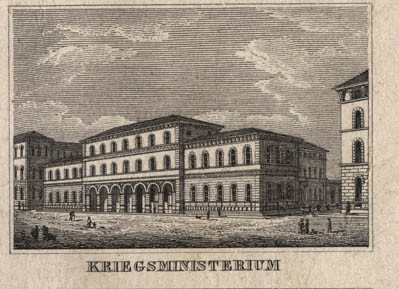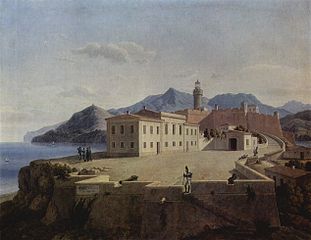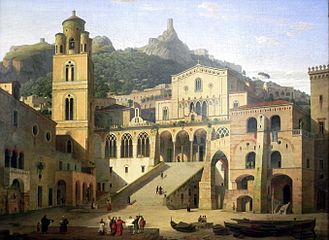Leo von Klenze
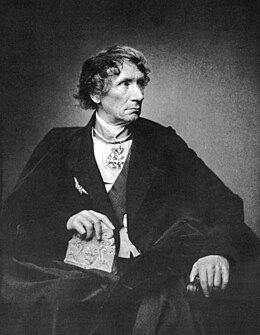
Leo Klenze , from 1822 von Klenze , completely Franz Karl Leopold Klenze , (born February 29, 1784 in Buchladen (Bockelah / Bocla) near Schladen ; † January 27, 1864 in Munich ; actually Franz Karl Leopold Klenze ) was a German architect , painter and writers . Along with Karl Friedrich Schinkel, he is considered to be the most important classicist architect .
Career
Leo Klenze was born in the night of February 29, 1784 in the forester's house in Buchladen (today "Boklah") near the village of Schladen am Harz as the son of Gotthelf Friedrich Klenze, bailiff in Schladen, and his wife Gertrud Josefa Theresia, née Meyer, and daughter of a doctor in Osnabrück. The family had seven children, Franz Karl Leopold was the first son and also the third child. The family lived in Schladen until 1791, after which they moved to Gut Heißum near Liebenburg , inherited from their paternal grandmother , where the youngest son Clemens August Karl , later professor of Roman legal history and rector at the Friedrich Wilhelms University in Berlin, was born.
At the age of 16 Leo Klenze began studying architecture in Berlin. Among other things, he learned from Aloys Hirt , through whom he came into contact with the ancient world, which shaped him architecturally throughout his life. He deepened his impressions on his first trip to Italy in the spring and summer of 1806 and many others that followed. At the Berlin Building Academy he studied again for three years and graduated as a conductor (a kind of supervisor of construction work).
From the beginning, Klenze placed great emphasis on developing and maintaining relationships. In Genoa he got to know Constantin La Flèche-Keudelstein , who became the master of ceremonies for the King of Westphalia Jérôme Bonaparte , and enabled him to get a job beyond his training. On February 1, 1808, Leo Klenze became the court architect of King Jérôme Bonaparte in Kassel . There he realized his first buildings and met his future wife Felicitas Blangini , who was a singer at the Kassel Theater. They married on August 28, 1813.
With the fall of Napoleon Bonaparte , Felicitas and Leo Klenze fled to Munich together with Felix Blangini (Felicitas' brother) at the end of October 1813 . Here Felix Blangini could turn to King Maximilian I Joseph von Wittelsbach , because he had held the position of Bavarian Kapellmeister since 1805. In addition, his sister Therese Blangini had been a Bavarian chamber singer since 1804 and personal singing teacher of the Bavarian Electress Karoline von Baden (from 1806 Queen Karoline of Bavaria).
After initial contact with Crown Prince Ludwig I without any professional results , Klenze and his wife moved to Paris , where their first son Hippolyt was born on July 21, 1814. When Klenze, after two further meetings with the Bavarian king, was hired as his private architect in October 1815, the family finally moved to Munich. There he built numerous buildings in Munich over the decades, which still shape the cityscape today.
family
He married the singer Felicitas Blangini (1790–1844) in Kassel in 1813 . The couple had three sons and three daughters, including:
- Hippolyt (* July 21, 1814 - March 6, 1880), Bavarian Colonel ∞ Emilie Farmer (* October 6, 1813 - August 8, 1878), parents of Everilda von Pütz
- Karoline (1817-1829)
- Eugen Lothar (1819–1822)
- Sophie Maria Leongilde Olympia (February 28, 1821 - December 25, 1849) ∞ Count Maximilian von Otting-Fünfstetten (1815–1901), Bavarian Obersthofmarschall, son of Karl Friedrich Stephan von Otting, Fünfstetten and Schönfeld , the half-brother of King Maximilian I. Joseph
- Ludwig Heliodor (1825-1851)
- Athenaide Walburga Maria (1828–1924) ∞ Count Maximilian von Otting-Fünfstetten (1815–1901)
The writer Everilda von Pütz born. von Klenze (1843–1926) was his granddaughter. His great-great-grandson Karl Graf von Spreti was also active as an architect, but was best known as a member of the Bundestag and diplomat .
tomb
The tomb of Leo Klenze is on the old southern cemetery in Munich (New Arkadenplatz 171 at cemetery 29) location . His wife Felicitas von Klenze (* July 10, 1794; † November 9, 1844), as well as their children Max, Karoline and Eugen are also in the grave.
The tomb is by Anselm Sickinger , the bust by Johann Halbig . Since the bust shows the year 1865, it can be assumed that the tomb was erected in that year.
Works
architecture
Klenze's first building was the ballroom at Wilhelmshöhe Castle near Kassel. The neo-classical building was built in 1809/1810 under Jérôme , King of Westphalia and brother of Napoleon , as a court theater. From 1828 to 1830, Johann Conrad Bromeis transformed it into a ballroom on behalf of Elector Wilhelm II of Hessen-Kassel.
Leo von Klenze became particularly important in his position as court architect of King Ludwig I of Bavaria (alongside his rival Friedrich von Gärtner ). His areas of responsibility included the classicistic redesign of Munich with z. B. the Marstall , Königsplatz , Ludwigstrasse , the Glyptothek , the Haslauer-Block , the Ruhmeshalle , the Alte Pinakothek or the Residenz . With his idealistic vision of a modern rebirth of Greek architecture, he was not without controversy, as contemporary travel reports show.
In 1816, at the request of Napoleon's stepson, Eugen Beauharnais , the Duke of Leuchtenberg , and his wife Auguste Amalie , Klenze rebuilt Ismaning Castle in a classical style. The Palais Leuchtenberg , created in the years 1817–1821, received its first odorless movable floor , an innovation in the development of sanitary systems that was first developed in Paris. To this end, Klenze went to the French capital specifically to study this technical achievement on site.
Between 1826 and 1828 the Odeon and the New Biederstein Castle were built according to his plans , and the Church of Our Lady in Fürth from 1826–1829 . Other realized buildings are the Monopteros , a small polychrome decorated round temple in the English Garden (1832–1837), which is considered to be an important architectural ensemble in Munich.
He created the Walhalla near Regensburg , the Liberation Hall in Kelheim , the constitutional column in Gaibach and the canal monument on Burgberg in Erlangen . These were often completed with groups of figures by the Bavarian sculptor Ludwig Schwanthaler . From 1828 Klenze played a key role in the construction of the Ingolstadt fortress .
Tsar Nicholas I was so pleased with the Alte Pinakothek during a visit to Munich that he commissioned Leo von Klenze to build the New Hermitage in Saint Petersburg , which was built between 1839 and 1852. The classicistic redesign of the city of Athens , which however largely disappeared due to a later redesign, goes back to him. He provided the urban planning concept for this on behalf of Otto I of Greece .
Bavarian War Ministry in Munich in 1832 (built in 1822)
The German special postage stamp for the 225th birthday in 2009 shows the Propylaea on Munich's Königsplatz
Atlases in the New Hermitage , Saint Petersburg
painting
In addition to architectural work, Klenze was also fascinated by painting, which at the time was mostly a prerequisite for the representation of building projects. But independent oil paintings were created, as the small selection shows:
Napoleon in Portoferraio , 1839
Idealized view of the Acropolis and Areopagus , 1846
Correspondence with Ludwig I.
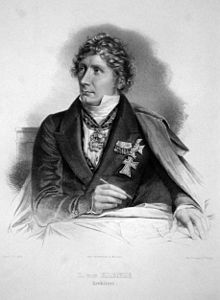
The correspondence between Klenze and Ludwig I has been preserved. In 1998 Hubert Glaser formed a working group at the University of Munich with the aim of commenting on and editing the artist correspondence of King Ludwig I of Bavaria. The focus of this working group was the king's correspondence with Klenze, which comprised around 1700 pieces. The letters are supplemented by statements, memoranda and cost estimates; in addition, there are related instructions from the king to his cabinet secretariat. In 2004 she presented the first results (see below the section Literature / Editions).
The art policy of Ludwig I of Bavaria is a typical example of the efforts of 19th century monarchs to represent and stabilize their rule through monumental buildings and art collections , to win over the educated or wealthy part of the citizens and to the existing political ones To bind order . Ludwig I succeeded in developing Munich into a European art center that reached as far as Paris (the museum was founded by King Louis-Philippe I ), London (hearing in the lower house on art development in Bavaria), St. Petersburg ( New Hermitage ) and Athens (Urban design, residential building, monument protection) radiated.
Honors
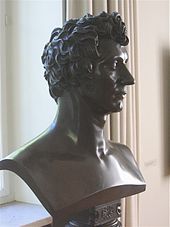
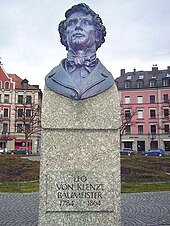
Awards during his lifetime
In 1822 Klenze was raised to the personal and in 1833 to the hereditary Bavarian nobility. In 1841 he was accepted as an external member of the Académie des Beaux-Arts . In 1852 he was awarded the Royal Gold Medal . On May 31, 1861, Klenze was accepted into the Prussian order Pour le Mérite for science and the arts. In 1862 Klenze became an honorary citizen of the city of Munich.
Posthumous honors
Franz Reber (1834–1919) gave a speech of thanks to the Bavarian Architects and Engineers Association in Munich on the occasion of the hundredth birthday.
A Klenze bust was placed in the Hall of Fame in Munich.
The Klenzestrasse in Werries , Munich , Regensburg and Tutzing , the Klenze-Gymnasium Munich , the State Vocational School II Ingolstadt and the Klenzepark in Ingolstadt and Klenzeplatz on the former area of the Maximilian colliery . The reason for the name was that Klenze is said to have been the favorite architect of the Bavarian King Maximilian II Joseph, who gave the colliery its name .
The Leo von Klenze Medal has been awarded by the Supreme Building Authority in the Bavarian State Ministry of the Interior since 1996 for outstanding achievements in architecture, housing and urban development and civil engineering.
literature
in alphabetical order by authors / editors
About Leo von Klenze
- Adrian von Buttlar : Leo von Klenze. Life - work - vision. Verlag CH Beck, Munich 1999, ISBN 3-406-45315-5 .
- Adrian von Buttlar: Leo von Klenze. Life - work - vision. 2nd Edition. Verlag CH Beck, Munich 2014, ISBN 978-3-406-66364-2 .
- Daniela Crescenzio: Italian Walks in Munich, Volume I - Florence Venice Rome. 3. Edition. IT-INERARIO, Rosenheim 2012, ISBN 978-3-9813046-5-7 , pp. 42-60, pp. 90-96.
- Daniela Crescenzio: Italian Walks in Munich, Volume III - Italian Women in Munich. IT-INERARIO, Rosenheim 2013, ISBN 978-3-9813046-6-4 , pp. 79-84.
- Franziska Dunkel, Hans-Michael Körner , Hannelore Putz (eds.): King Ludwig I of Bavaria and Leo von Klenze. Symposium on the occasion of Hubert Glaser's 75th birthday. Verlag CH Beck, Munich 2006, ISBN 3-406-10669-2 .
- Glyptothek Munich (ed.): A Greek dream. Leo von Klenze the archaeologist. Self-published, Munich 1986.
- Gothaisches genealogical pocket book of noble houses, 1921, p. 421f
- Oswald Hederer: Klenze, Leo von. In: New German Biography (NDB). Volume 12, Duncker & Humblot, Berlin 1980, ISBN 3-428-00193-1 , pp. 45-47 ( digitized version ).
- Rudolf Reiser: Klenze's secret memoir. The great architect as a chronicler and critic. Buchendorfer, Munich 2004, ISBN 3-937090-08-8 .
- Alexander Moutchnik : 1812 год в исторической памяти Мюнхена и Баварии. Обелиск на Каролинской площади в Мюнхене как место памяти . [The year 1812 in Munich and Bavaria's memory. The obelisk on Karolinenplatz in Munich as a place of remembrance]. International Conference "After the Storm. The Historical Memory upon 1812 in Russia and Europe “, German Historical Institute, Moscow, 28. – 30. May 2012.
- Winfried Nerdinger , S. Hildebrandt, T. Weidner, U. Steiner: Leo von Klenze. Architect between art and court 1784–1864 Prestel, Munich 2002, ISBN 3-7913-2822-0 .
- Marina Schneede : Leo von Klenzes "Instructions for the Architecture of the Christian Cult" , Munich, 1974, 61 pp.
- Rudolf Wiegmann : The knight Leo von Klenze and our art. Schreiner, Düsseldorf 1836 ( full text in the Google book search)
- Friedrich Pecht : Klenze, Leo von . In: Allgemeine Deutsche Biographie (ADB). Volume 16, Duncker & Humblot, Leipzig 1882, pp. 162-166.
- Raimund Wünsche , Friedrich Wilhelm Hamdorf, Adrian von Buttlar, Michael Tiede: A Greek dream - Leo von Klenze. The archaeologist , Munich 1986, Glyptothek publishing house
Editions
-
Hubert Glaser (ed.): King Ludwig I of Bavaria and Leo von Klenze. The correspondence = sources for the modern history of Bavaria. Department V / I. 3 volumes. Süddeutscher Verlag, Munich 2004 ff:
- Volume 1: Crown Prince's time of King Ludwig I. 3 volumes. 2004, ISBN 3-7696-9708-1 .
- Volume 2: The royal era. 3 volumes. 2007, ISBN 978-3-7696-6611-3 .
- Volume 3: After King Ludwig I renounced the throne, 3 volumes. 2011, ISBN 978-3-7696-6613-7 .
- Florian Hufnagl: Leo von Klenze and the “Collection of Architectural Drafts” . Wernersche Verlagsgesellschaft, Worms 1983. Reprint of the edition published in Cotta'schen Verlagbuchhandlung 1830–1850. Normal edition: ISBN 978-3-88462-017-5 ; Special edition: ISBN 978-3-88462-022-9 .
Web links
- Literature by and about Leo von Klenze in the catalog of the German National Library
- Works by and about Leo von Klenze in the German Digital Library
- Leo von Klenze. In: arch INFORM .
- Works by Leo von Klenze at Zeno.org .
- Getty Museum entry about Leo von Klenze (English)
- Estate in the Bavarian State Library
- Video at ARD-Alpha, 16 min. (Online until February 20th, 2021) Stories of great spirits: Red carpet for art Leo von Klenze, Friedrich von Gärtner, Ferdinand Lang discuss on a stage in the old southern cemetery.
Individual evidence
- ↑ Preface In: Adrian von Buttlar: Leo von Klenze. Life - work - vision. 2nd Edition. Verlag CH Beck, Munich 2014, ISBN 978-3-406-66364-2 , pp. 7-9.
- ↑ a b c Apprenticeship and travel years 1784–1807 In: Adrian von Buttlar : Leo von Klenze. Life - work - vision. 2nd Edition. Verlag CH Beck, Munich 2014, ISBN 978-3-406-66364-2 , p. 26.
- ^ Daniela Crescenzio: Italian Walks in Munich, Volume I - Florence Venice Rome. 3. Edition. IT-INERARIO, Rosenheim 2012, ISBN 978-3-9813046-5-7 , p. 42.
- ^ Daniela Crescenzio: Italian Walks in Munich, Volume III - Italian Women in Munich. IT-INERARIO, Rosenheim 2013, ISBN 978-3-9813046-6-4 , p. 79ff.
- ↑ Claudia Denk, John Ziesemer: Grabstätte 161 . In: Art and Memoria, The Old Southern Cemetery in Munich . 2014, p. 463 ff.
- ^ Hans Kratzer: Dickskädel am Bau - The correspondence between Ludwig I and Leo von Klenze is now completely edited. In: Süddeutsche Zeitung. January 25, 2011.
- ^ Letters between Ludwig I and Leo von Klenze, LMU Munich, Faculty of History and Art, Department of Bavarian History
- ^ The royal gold medal of the "Royal Institute of British Architects" Centralblatt der Bauverwaltung , July 1, 1882, p. 235, accessed on December 11, 2012.
- ↑ The Order Pour le Mérite for Science and the Arts. The members of the order. Volume I, Gebr.-Mann-Verlag, Berlin 1975, p. 228.
- ^ Acceptance speech , Im Centralblatt der Bauverwaltung , No. 20, May 17, 1884, pp. 196 to 198, accessed on December 28, 2012.
- ↑ City gazette for Hamm and Bönen. July 10, 2013, p. 19.
| personal data | |
|---|---|
| SURNAME | Klenze, Leo von |
| ALTERNATIVE NAMES | Klenze, Franz Karl Leopold (real name) |
| BRIEF DESCRIPTION | German architect, painter and writer |
| DATE OF BIRTH | February 29, 1784 |
| PLACE OF BIRTH | Bookstore (Bockelah / Bocla) near Schladen |
| DATE OF DEATH | January 27, 1864 |
| Place of death | Munich |



